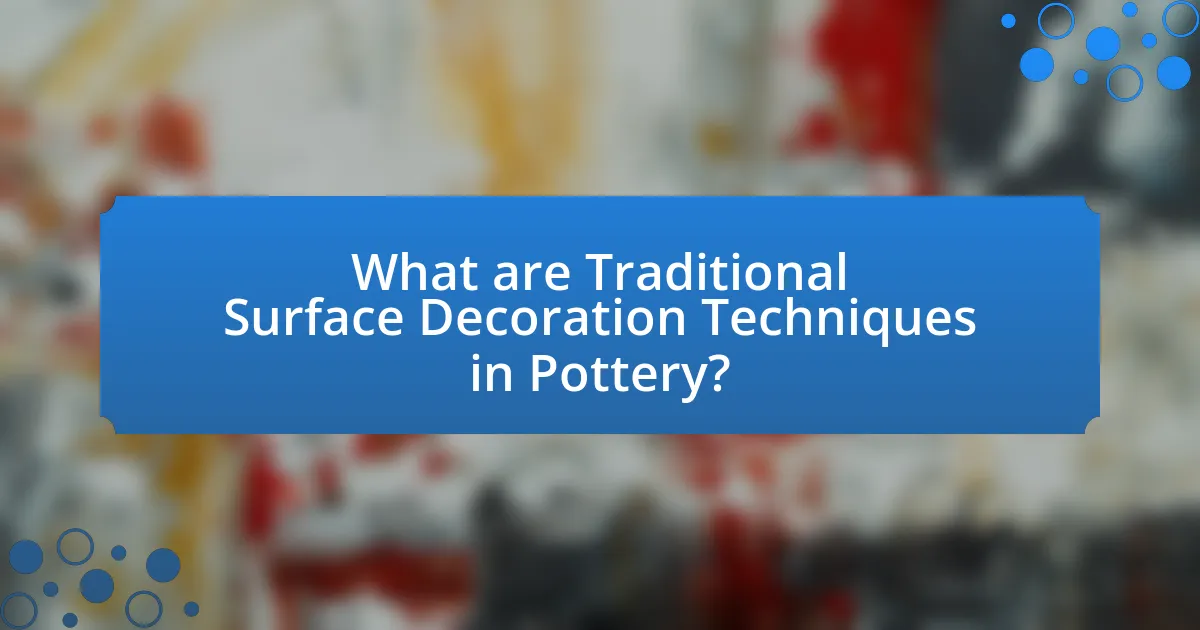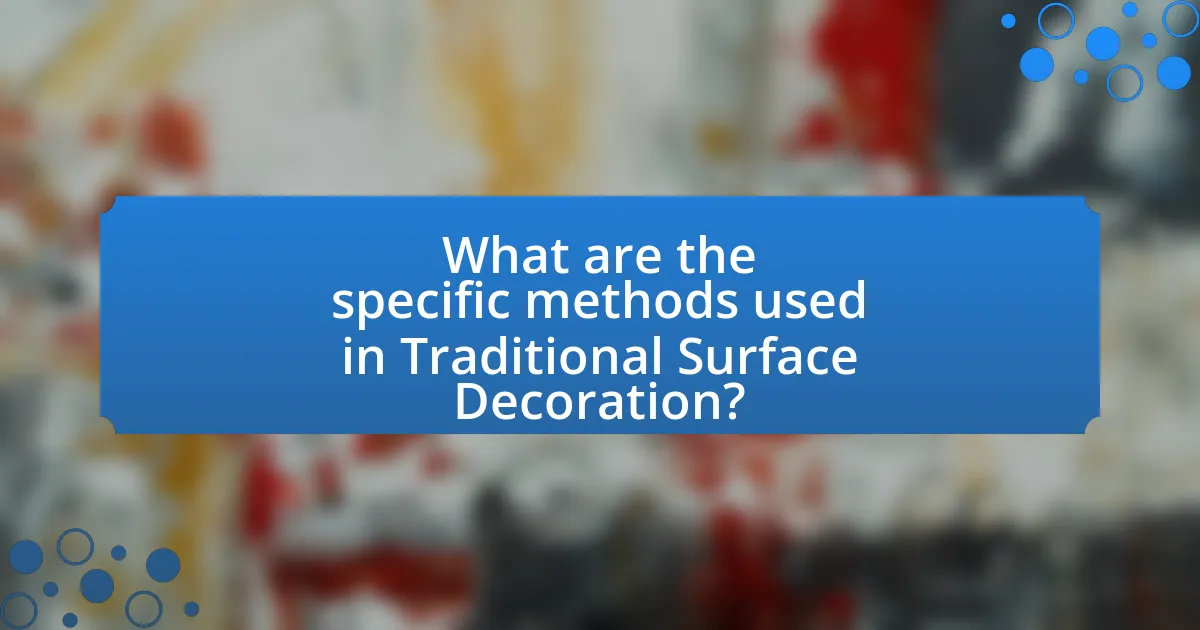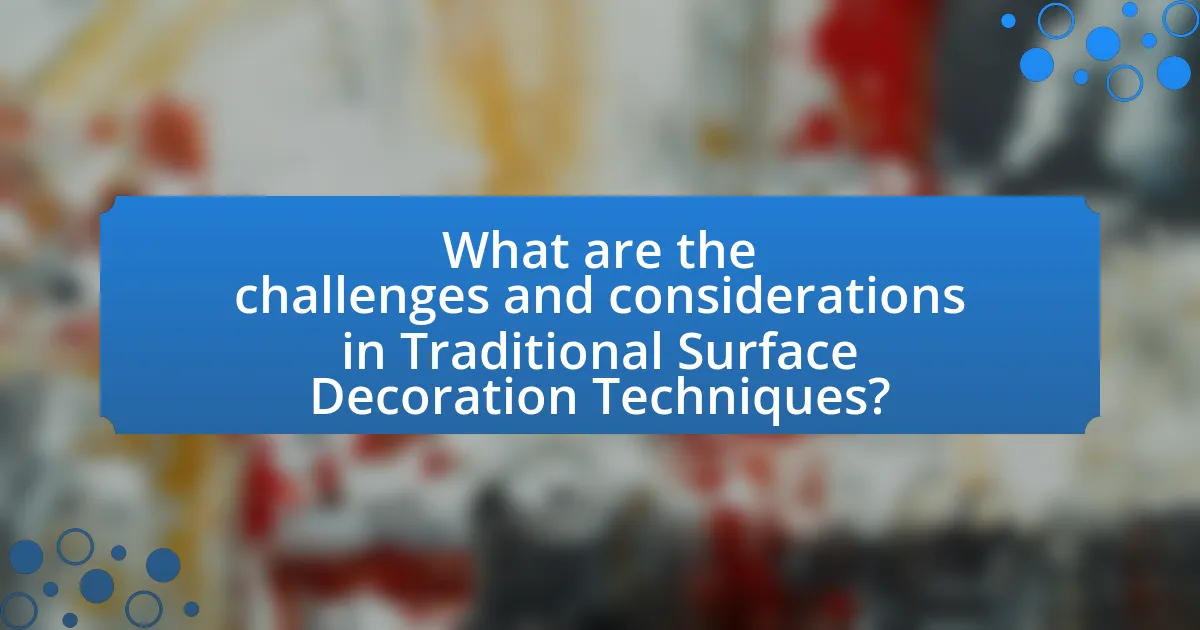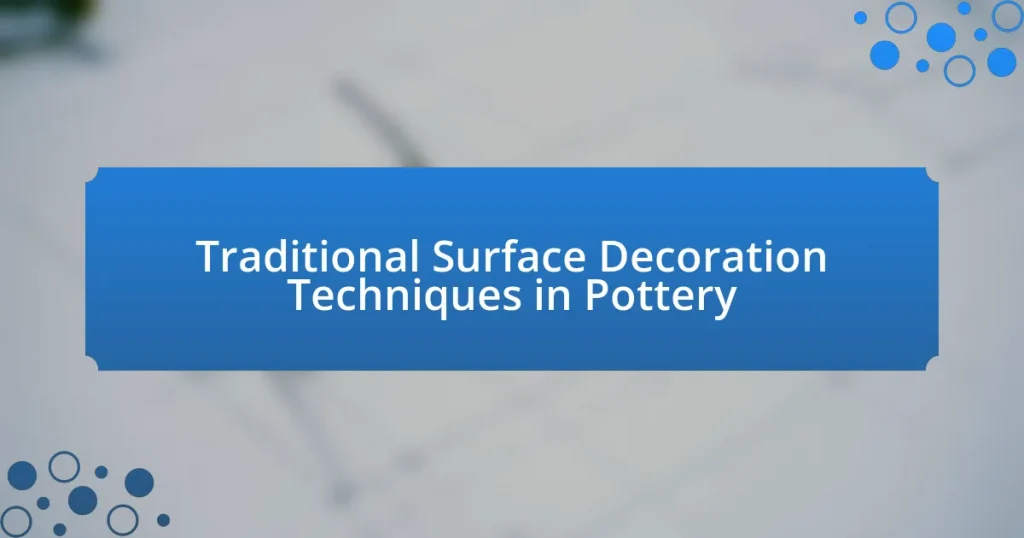Traditional surface decoration techniques in pottery encompass methods such as slip trailing, sgraffito, underglazing, and glazing, each contributing to the aesthetic and functional qualities of ceramic pieces. These techniques have evolved over time, influenced by historical developments and cultural exchanges, leading to a rich diversity in styles and applications across different regions. The article explores the materials and tools used in these techniques, the impact of cultural differences, and the challenges faced by artisans in maintaining traditional practices. Additionally, it highlights the significance of proper application methods and offers resources for learning and adapting these techniques in modern pottery.

What are Traditional Surface Decoration Techniques in Pottery?
Traditional surface decoration techniques in pottery include methods such as slip trailing, sgraffito, underglazing, and glazing. Slip trailing involves applying liquid clay (slip) onto the surface to create raised designs, while sgraffito entails scratching through a layer of slip to reveal the clay body underneath, allowing for intricate patterns. Underglazing is the application of color beneath a clear glaze, providing a durable finish, and glazing itself involves coating the pottery with a glass-like substance that can enhance color and texture. These techniques have been utilized for centuries across various cultures, demonstrating their significance in the art of pottery.
How have these techniques evolved over time?
Traditional surface decoration techniques in pottery have evolved significantly from ancient practices to contemporary methods. Initially, these techniques included simple hand-painted designs and natural pigments, as seen in prehistoric pottery from cultures such as the Jomon in Japan and the Native American Pueblo peoples. Over time, advancements in technology introduced new materials and tools, allowing for more intricate designs and the use of glazes, which became prominent during the Renaissance in Europe. The Industrial Revolution further transformed these techniques by enabling mass production and the introduction of transfer printing, which allowed for uniform patterns across pottery pieces. Today, modern pottery incorporates digital printing and mixed media, reflecting a blend of traditional craftsmanship and contemporary artistic expression. This evolution illustrates a continuous adaptation to cultural influences, technological advancements, and artistic innovation in the field of pottery.
What historical influences shaped these techniques?
Traditional surface decoration techniques in pottery have been shaped by various historical influences, including cultural exchanges, technological advancements, and regional practices. For instance, the introduction of glazing techniques in ancient Mesopotamia around 3000 BCE significantly impacted pottery decoration, allowing for more vibrant colors and intricate designs. Additionally, the influence of Chinese pottery, particularly during the Tang and Ming dynasties, introduced new aesthetic standards and methods, such as underglaze painting and the use of cobalt blue. These historical developments reflect the evolution of artistic expression and craftsmanship in pottery across different civilizations, demonstrating how cultural interactions and innovations have continuously shaped these traditional techniques.
How do cultural differences impact surface decoration methods?
Cultural differences significantly impact surface decoration methods in pottery by influencing design choices, techniques, and materials used. For instance, in Japanese pottery, the aesthetic of wabi-sabi emphasizes simplicity and natural imperfections, leading to unique glazing techniques that reflect this philosophy. In contrast, Mexican pottery often features vibrant colors and intricate patterns, showcasing cultural narratives and traditions through the use of slip decoration and bold glazes. These variations illustrate how cultural values shape artistic expression, resulting in distinct surface decoration methods that are rooted in the respective cultural contexts.
What materials are commonly used in these techniques?
Common materials used in traditional surface decoration techniques in pottery include slip, underglaze, glaze, and natural pigments. Slip, a liquid mixture of clay and water, is often applied to create texture or color on pottery surfaces. Underglaze, which consists of colored clay or stains, is used for detailed designs before the final glaze is applied. Glaze, a glass-like coating, provides a finished surface that can enhance color and durability. Natural pigments, derived from minerals and plants, are utilized for painting and decorating pottery, offering a range of colors and effects. These materials have been historically significant in various cultures, as evidenced by archaeological findings that showcase their use in ancient pottery artifacts.
What types of clay are preferred for surface decoration?
Earthenware and stoneware clays are preferred for surface decoration in pottery. Earthenware is favored for its porous nature, allowing for easy application of slips and underglazes, while stoneware offers a sturdier surface that can withstand higher firing temperatures, making it suitable for various decorative techniques. Both types of clay provide a good canvas for glazes and surface treatments, enhancing the aesthetic appeal of the finished piece.
How do glazes and slips contribute to decoration?
Glazes and slips significantly enhance the decorative quality of pottery by providing color, texture, and surface finish. Glazes, which are glass-like coatings applied to ceramics, can create a wide range of visual effects, from glossy to matte finishes, and can incorporate various colors and patterns through techniques such as layering and spraying. Slips, which are liquid clay mixtures, can be used for painting or as a base layer, allowing for intricate designs and textures to be added before firing. Historical evidence shows that ancient cultures, such as the Chinese during the Tang Dynasty, utilized glazes to achieve vibrant colors and intricate designs, demonstrating their importance in pottery decoration.
What are the main categories of surface decoration techniques?
The main categories of surface decoration techniques in pottery are glazing, painting, carving, and inlaying. Glazing involves applying a glass-like coating to the pottery surface, which can enhance color and provide a waterproof finish. Painting refers to the application of pigments directly onto the surface, allowing for intricate designs and patterns. Carving, or incising, involves removing material from the surface to create textures or images, often revealing contrasting colors beneath. Inlaying consists of embedding materials into the surface to create decorative patterns or images. Each technique has historical significance and varies in application across different cultures and pottery styles.
What is the difference between incised and impressed decoration?
Incised decoration involves carving or cutting into the surface of a material to create designs, while impressed decoration entails pressing a tool or object into the surface to leave a design without removing material. Incised techniques often result in deeper, more defined lines, whereas impressed techniques create raised or indented patterns. Historical pottery examples, such as ancient Greek ceramics, showcase incised designs that highlight intricate details, while impressed decorations can be seen in Native American pottery, where natural objects were used to create textures.
How do painting and glazing techniques differ in application?
Painting and glazing techniques differ primarily in their application methods and intended outcomes. Painting involves applying colored pigments directly onto the surface of pottery, often using brushes or sponges, to create designs that remain on the surface after firing. In contrast, glazing involves applying a liquid glass-like coating that fuses to the pottery during the firing process, resulting in a smooth, often shiny finish that can enhance color and durability. The application of glaze typically requires a more uniform and even coating to ensure proper adhesion and a consistent finish, while painting allows for more artistic freedom and detail.

What are the specific methods used in Traditional Surface Decoration?
Traditional surface decoration in pottery employs specific methods such as slip trailing, sgraffito, underglazing, and overglazing. Slip trailing involves applying a liquid clay mixture to create raised designs on the surface, while sgraffito entails scratching through a layer of slip to reveal the clay body underneath, creating intricate patterns. Underglazing is the technique of applying color beneath a clear glaze, allowing for detailed artwork that remains visible after firing. Overglazing, on the other hand, involves applying decorative elements on top of a fired glaze, which can then be refired to set the decoration. These methods have been utilized for centuries across various cultures, demonstrating their significance in the art of pottery decoration.
How is slip trailing applied in pottery decoration?
Slip trailing is applied in pottery decoration by using a tool, often a squeeze bottle or a piping bag, to apply a liquid clay mixture, known as slip, onto the surface of the pottery. This technique allows for the creation of raised designs and intricate patterns, as the slip can be applied in various thicknesses and shapes. Historically, slip trailing has been utilized in various cultures, including the Islamic pottery tradition, where it was used to enhance the visual appeal of ceramics through detailed motifs and designs.
What tools are used for slip trailing?
Slip trailing primarily utilizes tools such as squeeze bottles, piping bags, and brushes. Squeeze bottles allow for controlled application of slip, enabling artists to create intricate designs. Piping bags, similar to those used in cake decorating, provide precision for fine lines and detailed patterns. Brushes can also be employed for broader strokes or to blend slip into the surface. These tools facilitate the traditional technique of applying liquid clay (slip) onto pottery, enhancing its decorative appeal.
What effects can be achieved through slip trailing?
Slip trailing can achieve a variety of decorative effects on pottery, including raised patterns, intricate designs, and textural contrasts. This technique involves applying a liquid clay mixture, known as slip, onto the surface of a pottery piece, allowing for precise control over the design. The raised lines created by slip trailing can enhance visual interest and depth, making the pottery more aesthetically appealing. Additionally, slip trailing can be used to create contrasting colors and patterns, as different slips can be applied to achieve unique effects. Historical examples demonstrate that cultures have utilized slip trailing to create both functional and artistic pottery, showcasing its versatility and significance in traditional ceramic practices.
What role does sgraffito play in pottery decoration?
Sgraffito plays a significant role in pottery decoration by allowing artisans to create intricate designs through the technique of scratching through a surface layer to reveal a contrasting color underneath. This method enhances the visual appeal of pottery, as it enables the application of detailed patterns and textures that can be both decorative and functional. Historically, sgraffito has been utilized in various cultures, such as in Italian Renaissance pottery, where it was employed to produce elaborate motifs, demonstrating its effectiveness in elevating the aesthetic quality of ceramic pieces.
How is the sgraffito technique executed?
The sgraffito technique is executed by applying a layer of slip (liquid clay) to a pottery surface and then scratching through this layer to reveal the underlying clay body. This process typically involves first shaping the pottery and allowing it to dry to a leather-hard state. Once the slip is applied, artists use various tools to incise designs, which can range from simple lines to intricate patterns. The technique is often completed by firing the piece in a kiln, which enhances the contrast between the slip and the exposed clay, resulting in a visually striking effect. Historical evidence shows that sgraffito has been used since ancient times, particularly in Italian Renaissance pottery, demonstrating its long-standing significance in ceramic art.
What are the visual outcomes of using sgraffito?
The visual outcomes of using sgraffito include intricate designs and contrasting colors that enhance the aesthetic appeal of pottery. This technique involves scratching through a surface layer to reveal a different color underneath, resulting in detailed patterns and textures. The contrast between the exposed clay and the slip creates a striking visual effect, often characterized by sharp lines and defined shapes. Historical examples, such as Italian Renaissance pottery, showcase the effectiveness of sgraffito in producing visually captivating pieces that highlight craftsmanship and artistic expression.
How does underglaze painting differ from overglaze painting?
Underglaze painting involves applying color to pottery before the glaze is added, while overglaze painting occurs after the glaze has been applied and fired. In underglaze techniques, the colors are typically more muted and can be more intricate, as they are absorbed into the clay body during the initial firing. In contrast, overglaze techniques allow for brighter colors and detailed designs, as the pigments sit on top of the glaze and are often fired at a lower temperature in a second firing. This distinction is crucial in pottery, as it affects the final appearance and durability of the decorative elements.
What are the advantages of underglaze painting?
The advantages of underglaze painting include its ability to provide vibrant colors and intricate designs while maintaining durability and stability during firing. Underglaze painting allows artists to apply detailed patterns and images on pottery before the glaze is applied, ensuring that the colors remain true and do not bleed. This technique also offers greater control over the final appearance, as it can be layered and combined with other decorative methods. Additionally, underglaze-painted pieces are often more resistant to chipping and fading compared to those decorated with overglaze techniques, making them suitable for functional ware.
What techniques are used in overglaze painting?
The techniques used in overglaze painting include the application of colored glazes, luster effects, and gold or metallic embellishments. These methods allow artists to create intricate designs and vibrant colors on pottery after the initial glaze firing. For instance, colored glazes are applied to the surface and then fired at a lower temperature, which helps to preserve the brightness of the colors. Luster effects are achieved by applying metallic compounds that produce a reflective surface when fired. Gold embellishments are often added for decorative purposes, enhancing the visual appeal of the pottery. These techniques have been historically significant in various cultures, particularly in European and Asian ceramics, where they contributed to the aesthetic richness of pottery.

What are the challenges and considerations in Traditional Surface Decoration Techniques?
Traditional surface decoration techniques in pottery face several challenges and considerations, including material compatibility, skill level, and environmental factors. Material compatibility is crucial, as different clays and glazes may react unpredictably during firing, leading to defects or undesirable results. The skill level of the artisan significantly impacts the quality of the decoration; traditional methods often require years of practice to master techniques such as slip trailing or sgraffito. Environmental factors, such as humidity and temperature, can also affect the drying and firing processes, potentially compromising the final outcome. These challenges necessitate careful planning and execution to achieve successful results in traditional pottery decoration.
What common mistakes should be avoided in surface decoration?
Common mistakes to avoid in surface decoration include improper surface preparation, which can lead to poor adhesion of decorative elements. For instance, failing to clean or prime the surface can result in uneven application and peeling. Additionally, using incompatible materials, such as certain glazes with specific clay bodies, can cause defects during firing. Another mistake is neglecting to test decorative techniques on sample pieces, which can lead to unexpected results on the final work. Lastly, overloading the surface with too many decorative elements can overwhelm the design, detracting from the overall aesthetic. These mistakes can significantly impact the quality and appearance of the finished pottery.
How can improper application affect the final product?
Improper application of traditional surface decoration techniques in pottery can lead to defects such as uneven glazing, poor adhesion, and aesthetic inconsistencies. These defects occur because incorrect methods, such as applying glaze too thickly or unevenly, can result in areas that do not properly bond to the clay body, leading to flaking or peeling. Additionally, improper firing temperatures can cause colors to distort or not develop as intended, affecting the visual appeal of the final product. Studies have shown that adherence to proper application techniques significantly enhances the durability and aesthetic quality of pottery, underscoring the importance of precision in the decoration process.
What are the best practices for achieving desired effects?
The best practices for achieving desired effects in traditional surface decoration techniques in pottery include careful selection of materials, precise application methods, and thorough understanding of firing processes. Using high-quality glazes and underglazes ensures vibrant colors and durability, while techniques such as slip trailing, sgraffito, and stenciling allow for intricate designs. Additionally, controlling the temperature and atmosphere during firing can significantly impact the final appearance of the pottery, as evidenced by the fact that different firing atmospheres can alter glaze chemistry and color outcomes.
How can one maintain the integrity of traditional techniques?
To maintain the integrity of traditional techniques in pottery, artisans should prioritize the use of authentic materials and methods passed down through generations. This adherence ensures that the cultural significance and craftsmanship inherent in these techniques are preserved. For example, using locally sourced clay and traditional firing methods, such as wood or pit firing, reflects the historical practices of specific cultures, thereby maintaining the authenticity of the pottery. Additionally, documenting these techniques through workshops and educational programs can help pass on knowledge to future generations, ensuring that the traditional practices are not lost over time.
What resources are available for learning these techniques?
Books, online courses, and workshops are available for learning traditional surface decoration techniques in pottery. Notable books include “The Potter’s Bible” by Anne M. McGowan, which covers various techniques and methods, and “Ceramics: A Potter’s Handbook” by Glenn C. Nelson, providing foundational knowledge. Online platforms like Skillshare and Udemy offer courses specifically focused on pottery decoration techniques, allowing learners to access expert instruction at their convenience. Additionally, local art centers and community colleges often host hands-on workshops, providing practical experience and guidance from skilled artisans. These resources collectively support a comprehensive understanding of traditional pottery decoration methods.
How can modern potters adapt traditional methods in their work?
Modern potters can adapt traditional methods by integrating contemporary materials and technologies while preserving the core techniques of hand-building, glazing, and firing. For instance, they can use traditional slip decoration alongside modern underglazes to achieve vibrant colors and intricate designs that were not possible with historical materials. Additionally, potters can experiment with electric kilns to replicate traditional firing techniques, such as reduction firing, which enhances the depth of glazes. This blending of old and new allows for innovation while respecting the heritage of pottery, as seen in the works of contemporary artists who draw inspiration from historical practices yet utilize modern tools and methods to expand their creative possibilities.
What tips can enhance the practice of Traditional Surface Decoration Techniques?
To enhance the practice of Traditional Surface Decoration Techniques in pottery, artisans should focus on mastering the foundational skills of surface preparation, tool selection, and design application. Proper surface preparation, including cleaning and smoothing the clay, ensures better adhesion of decorative elements. Selecting the right tools, such as brushes, stamps, and carving implements, allows for more precise and varied designs. Additionally, studying historical examples and techniques from different cultures can inspire innovative approaches while maintaining traditional integrity. Research indicates that artists who engage in continuous learning and experimentation with materials and methods tend to produce more refined and culturally resonant works.

